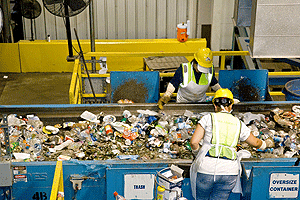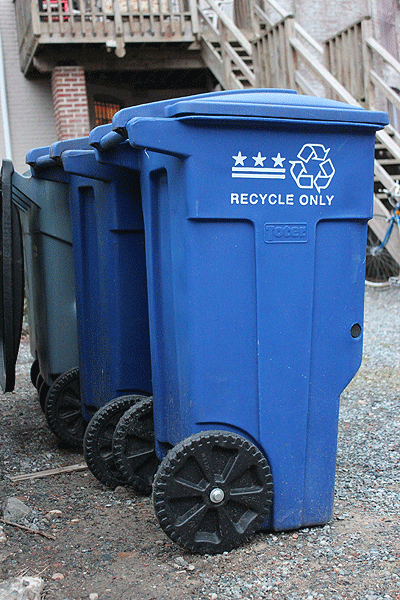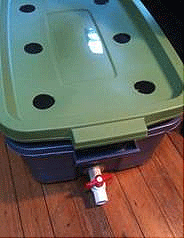The Economic Power of Recycling: Sustainable Materials Management
By Mathy Stanislaus
On America Recycles Day, we’re taking a look back over the last 40 years since the passage of the Resource Conservation and Recovery Act (RCRA) and how we’ve worked to protect the health of our country’s communities through resource conservation. Here at EPA, recycling is a key element of Sustainable Materials Management (SMM), a systemic approach to using and reusing materials more productively over their entire life cycles. SMM represents a global shift in the use of natural resources and environmental protection. America’s recycling and reuse activities accounted for 757,000 jobs, produced $36.6 billion in wages and generated $6.7 billion in tax revenues in 2007, based on the most recent census data. As we continue to reduce, reuse and recycle, we are evolving our resource conservation efforts to use materials in the most productive way, with an emphasis on using less and advancing a circular economy.
Today we celebrate our successes in sustainable materials management. The national recycling rate has more than quadrupled from 7 to 34 percent, and the slogan Reduce, Reuse, Recycle has become a staple of American life. Recycling bins are now common in our homes, schools and workplaces; restaurants are composting their food waste and businesses are working with communities to offer consumers reuse and recycling opportunities.
In 2001, to encourage the development of an economic market for  recycling, we supported the creation of a national Recycling Economic Information (REI) Project and the related REI
recycling, we supported the creation of a national Recycling Economic Information (REI) Project and the related REI
report. The REI report was a groundbreaking national study demonstrating the economic value of recycling and reuse to the U.S. economy. Compiled through a cooperative agreement with the National Recycling Coalition, the study confirmed what many have known for decades: there are significant economic benefits associated with recycling.
That is why I am excited to announce the release of the 2016 REI Report. This report includes updated information about recycling jobs, wages, and tax revenue. We have found that recycling and reuse of materials creates jobs while also generating local and state tax revenues. According to the latest Census data available, in 2007 recycling and reuse activities in the United States accounted for:
- 757,000 jobs;
- $36.6 billion in wages; and
- $6.7 billion in tax revenues.
These are enough recycling jobs to employ more than the entire population of the city of Seattle, Washington. To break down those numbers a little more, every 1,000 U.S. tons of recyclable materials generates:
- 1.57 jobs;
- $76,030 in wages; and
- $14,101 in tax revenues.
Along with the new economic impacts, the 2016 REI report used an  updated analytical framework and a new waste input-output methodology, which focused on the life cycle of materials and defining recycling. These refinements offered significant improvements over the 2001 REI study in terms of a better definition of recycling and more precise data. This new methodology will help decision makers and researchers more accurately estimate the economic benefits of recycling and create a foundation upon which additional studies can be built.
updated analytical framework and a new waste input-output methodology, which focused on the life cycle of materials and defining recycling. These refinements offered significant improvements over the 2001 REI study in terms of a better definition of recycling and more precise data. This new methodology will help decision makers and researchers more accurately estimate the economic benefits of recycling and create a foundation upon which additional studies can be built.
In addition to the economic benefits, we must recognize the major environmental benefits of recycling and SMM as a whole. Recycling reduces pollution and greenhouse gases, while generating positive economic benefits. For example, in 2014, 89 million tons of municipal solid waste were recycled and composted. That’s equivalent to removing the carbon dioxide emissions of 38 million passenger cars from the road annually. How our society uses materials is fundamental to our economic and environmental future. Global competition for our limited resources will only intensify as the world population and economies grow. A more productive and less impactful use of materials will help our society remain economically competitive, contribute to our prosperity and protect the environment in a resource-constrained future. We want to make sure we have sufficient resources to meet not only today’s needs, but those of the future as well. As we celebrate our nation’s commitment to recycling our materials today, let’s shoot for 40 more years of continuing to sustainably conserve and manage our resources.
To read the REI Report, visit: https://www.epa.gov/smm/recycling-economic-information-rei-report
To read the President’s Proclamation: https://www.whitehouse.gov/the-press-office/2016/11/14/presidential-proclamation-america-recycles-day-2016





















